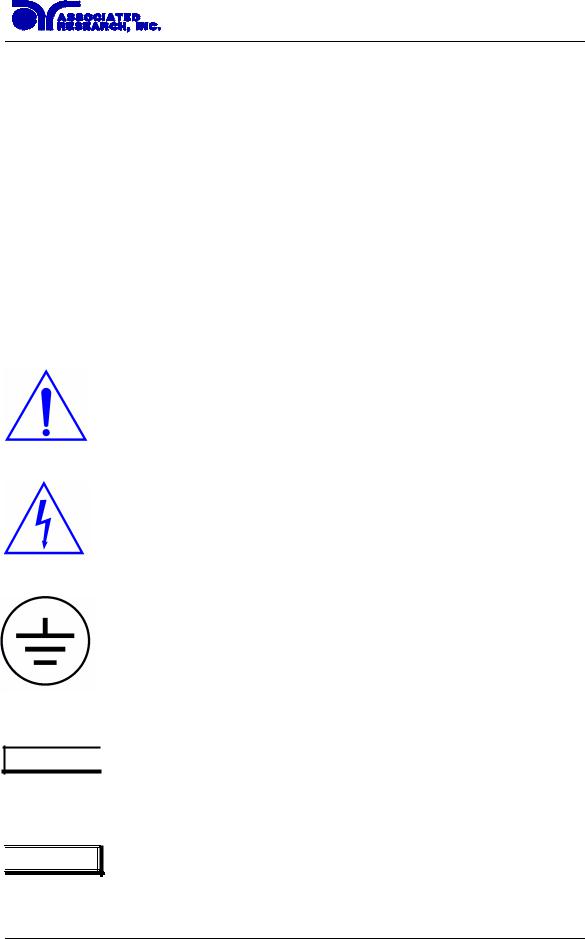Associated Research Hypot II 3565D, Hypot II 3570D, Hypot II 3505D, Hypot II 3500D Service manual

OPERATION AND SERVICE MANUAL
Hypot II
MODEL 3500D (AC ONLY HIPOT WITH GROUND CONTINUITY CHECK) MODEL 3505D (ENHANCED AC ONLY HIPOT WITH GROUND CONTINUITY CHECK)
MODEL 3565D (ENHANCED AC/DC HIPOT WITH GROUND CONTINUITY CHECK) MODEL 3570D (ENHANCED AC/DC HIPOT WITH IR AND GROUND CONTINUITY)
SERIAL NUMBER
Models |
|
© Associated Research, Inc., 2000 |
3500D/3505D |
13860 West Laurel Drive |
|
|
|
|
3565D/3570D |
Lake Forest, Illinois, 60045-4546 |
|
U.S.A. |
||
Item 37589 |
Ver 3.18 |
Printed Nov 6, 2000 |
i
5 YEAR WARRANTY POLICY
Associated Research, Inc., certifies that the instrument listed in this manual meets or exceeds published manufacturing specifications. This instrument was calibrated using standards that are traceable to the National Institute of Standards and Technology (NIST).
Your new instrument is warranted to be free from defects in workmanship and material for a period of (1) year from date of shipment. Options and accessories that are external to the instrument are warranted for a period of (90) days from date of shipment. You must return the “Owners Registration Card” provided within (15) days from receipt of your instrument.
AR recommends that your instrument be calibrated on a twelve month cycle. Instruments purchased and used in North America only, may have their warranty extended in one year increments to a maximum of (5) years provided they are returned to AR at least annually for calibration and inspection. The annual calibration and inspection must be performed annually each and every year following receipt of instrument. Any instrument not calibrated and inspected annually will not be eligible for extended warranty status. This extended warranty is non-transferable and is offered only to the original purchaser.
A return material authorization (RMA) must be obtained from AR before returning this instrument for warranty service. Please contact our Customer Support Center at 1-800-858-TEST (8378) to obtain an RMA number. It is important that the instrument is packed in its original container for safe transport. If the original container in not available please contact our customer support center for proper instructions on packaging. Damages sustained as a result of improper packaging will not be honored. Transportation costs for the return of the instrument for warranty service must be prepaid by the customer. AR will assume the return freight costs when returning the instrument to the customer. The return method will be at the discretion of Associated Research.
Except as provided herein, Associated Research makes no warranties to the purchaser of this instrument and all other warranties, express or implied (including, without limitation, merchantability or fitness for a particular purpose) are hereby excluded, disclaimed and waived.
Any non-authorized modifications, tampering or physical damage will void your warranty. Elimination of any connections in the earth grounding system or by-passing any safety systems will void this warranty. This warranty does not cover batteries or accessories not of Associated Research manufacture. Parts used must be parts that are recommended by AR as an acceptable specified part. Use of non-authorized parts in the repair of this instrument will void the warranty.
ii
TABLE OF CONTENTS |
|
SECTION I OPERATORS MANUAL |
............................................................................1 |
SAFETY ........................................................................................................................... |
2 |
INTRODUCTION ............................................................................................................ |
6 |
SPECIFICATIONS......................................................................................................... |
12 |
CONTROLS ................................................................................................................... |
18 |
INSTALLATION ........................................................................................................... |
21 |
QUICK START .............................................................................................................. |
24 |
OPERATION.................................................................................................................. |
27 |
OPTIONS ....................................................................................................................... |
42 |
SECTION II SERVICE MANUAL................................................................................ |
45 |
CALIBRATION ............................................................................................................. |
46 |
PARTS LIST................................................................................................................... |
49 |
SCHEMATICS............................................................................................................... |
50 |
iii
SECTION 1
OPERATORS MANUAL

SAFETY
SAFETY PRECAUTIONS REQUIRED FOR HIGH VOLTAGE TESTING!
GENERAL:
This product and its related documentation must be reviewed for familiarization with safety markings and instructions before operation.
This product is a Safety Class I instrument (provided with a protective earth terminal).
Before applying power verify that the instrument is set to the correct line voltage (115 or 230) and the correct fuse is installed.
INSTRUCTION MANUAL SYMBOL. PLEASE REFER TO THE INSTRUCTION MANUAL FOR SPECIFIC WARNING OR CAUTION INFORMATION TO AVOID PERSONAL INJURY OR DAMAGE TO THE PRODUCT.
WARNING 

 CAUTION
CAUTION
INDICATES HAZARDOUS VOLTAGES MAY BE PRESENT.
CHASSIS GROUND SYMBOL.
CALLS ATTENTION TO A PROCEDURE, PRACTICE, OR CONDITION, THAT COULD POSSIBLY CAUSE BODILY INJURY OR DEATH.
CALLS ATTENTION TO A PROCEDURE, PRACTICE, OR CONDITION, THAT COULD POSSIBLY CAUSE DAMAGE TO EQUIPMENT OR PERMANENT LOSS OF DATA.
2

SAFETY
A Hipot produces voltages and currents which can cause harmful or fatal electric shock. To prevent accidental injury or death, these safety procedures must be strictly observed when handling and using the test instrument.
SERVICE AND MAINTENANCE
User Service
To prevent electric shock do not remove the instrument cover. There are no user serviceable parts inside. Routine maintenance or cleaning of internal parts is not necessary. Any external cleaning should be done with a clean dry or slightly damp cloth. Avoid the use of cleaning agents or chemicals to prevent any foreign liquid from entering the cabinet through ventilation holes or damaging controls and switches, also some chemicals may damage plastic parts or lettering. Schematics, when provided, are for reference only. Any replacement cables and high voltage components should be acquired directly from Associated Research, Inc. Refer servicing to an Associated Research, Inc. authorized service center.
ASSOCIATED RESEARCH, INC. |
!PHONE: 1 (847) 367-4077 |
1 (800) 858-TEST (8378) |
|
13860 WEST LAUREL DRIVE |
FAX: 1 (847) 367-4080 |
LAKE FOREST, IL 60045-4546 U.S.A. |
E-MAIL : info@asresearch.com |
|
www.asresearch.com |
Service Interval
The instrument and its power cord, test leads, and accessories must be returned at least once a year to an Associated Research authorized service center for calibration and inspection of safety related components. Associated Research will not be held liable for injuries suffered if the instrument is not returned for its annual safety check and maintained properly.
User Modifications
Unauthorized user modifications will void your warranty. Associated Research will not be responsible for any injuries sustained due to unauthorized equipment modifications or use of parts not specified by Associated Research. Instruments returned to Associated Research with unsafe modifications will be returned to their original operating condition at your expense.
TEST STATION
Location
Select an area away from the main stream of activity which employees do not walk through in performing their normal duties. If this is not practical because of production line flow, then the area should be roped off and marked for HIGH VOLTAGE TESTING. No employees other than the test operators should be allowed inside.
3

SAFETY
If benches are placed back-to-back, be especially careful about the use of the bench opposite the test station. Signs should be posted: "DANGER - HIGH VOLTAGE
TEST IN PROGRESS - UNAUTHORIZED PERSONNEL KEEP AWAY."
Power
Dielectric Voltage-Withstand Test Equipment must be connected to a good ground. Be certain that the power wiring to the test bench is properly polarized and that the proper low resistance bonding to ground is in place.
Power to the test station should be arranged so that it can be shut off by one prominently marked switch located at the entrance to the test area. In the event of an emergency, anyone can cut off the power before entering the test area to offer assistance.
Work Area
Perform the tests on a nonconducting table or workbench, if possible.
There should not be any metal in the work area between the operator and the location where products being tested will be positioned.
Position the tester so the operator does not have to reach over the product under test to activate or adjust the tester. If the product or component being tested is small, it may be possible to construct guards or an enclosure, made of a non-conducting material such as clear acrylic, such that the item being tested is within the guards or enclosure during the test, and fit them with switches so that the tester will not operate unless the guards are in place or the enclosure closed.
Keep the area clean and uncluttered. All test equipment and test leads not absolutely necessary for the test should be removed from the test bench and put away. It should be clear to both the operator and to any observers which product is being tested, and which ones are waiting to be tested or have already been tested.
Do not perform Hipot tests in a combustible atmosphere or in any area where combustible materials are present.
TEST OPERATOR
Qualifications
This instrument generates voltages and currents which can cause harmful or fatal electric shock and must only be operated by a skilled worker trained in its use.
The operator should understand the electrical fundamentals of voltage, current, and resistance.
Safety Procedures
Operators should be thoroughly trained to follow these and all other applicable safety rules and procedures before they begin a test. Defeating any safety system should be treated as a serious offense and should result in severe penalties, such as removal from
4

SAFETY
the Hipot testing job. Allowing unauthorized personnel in the area during a test should also be dealt with as a serious offense.
Dress
Operators should not wear jewelry which could accidentally complete a circuit.
Medical Restrictions
This instrument should not be operated by personnel with heart ailments or devices such as pacemakers.
TEST PROCEDURES
!NEVER PERFORM A HIPOT TEST ON ENERGIZED CIRCUITRY OR EQUIPMENT!
If the instrument has an external safety ground connection be sure that this is connected. Then Connect the return lead first for any test regardless of whether the item under test is a sample of insulating material tested with electrodes, a component tested with the high voltage test lead, or a cord-connected device with a two or three prong plug.
Plug in the high voltage test lead only when it is being used. Handle its clip only by the insulator---never touch the clip directly. Be certain that the operator has control over any remote test switches connected to the Hipot. Double check the return and high voltage connections to be certain that they are proper and secure.
NEVER TOUCH THE ITEM UNDER TEST OR ANYTHING CONNECTED TO IT WHILE HIGH VOLTAGE IS PRESENT DURING THE HIPOT TEST.
When testing with DC, always discharge the capacitance of the item
WARNING under test and anything the high voltage may have contacted--such as test fixtures--before handling it or disconnecting the test leads.
HOT STICK probes can be used to discharge any capacitance in the item under test as a further safety precaution. A hot stick is a nonconducting rod about two feet long with a metal probe at the end which is connected to a wire. To discharge the device under test, two hot sticks are required. First connect both probe wires to a good earth ground. Then touch one probe tip to the same place the return lead was connected. While holding the first probe in place, touch the second probe tip to the same place where the high voltage lead was connected.
KEY SAFETY POINTS TO REMEMBER:
•Keep unqualified and unauthorized personnel away from the test area.
•Arrange the test station in a safe and orderly manner.
•Never touch the product or connections during a test.
•In case of any problem, turn off the high voltage first.
•Properly discharge any item tested with DC before touching connections.
5

INTRODUCTION
GLOSSARY OF TERMS
(as used in this manual)
Alternating Current, AC: Current which reverses direction on a regular basis, commonly in the U.S.A. 60 times per second, in other countries 50 times per second.
Breakdown: The failure of insulation to effectively prevent the flow of current, sometimes evident by arcing. If voltage is gradually raised, breakdown will begin suddenly at a certain voltage level. Current flow is not directly proportional to voltage. Once breakdown current has flown, especially for a period of time, a repeated application of voltage will often show breakdown beginning at a lower voltage than initially.
Conductive: Having a volume resistivity of no more than 103 ohm-cm or a surface resistivity of no more than 105 ohms per square.
Conductor: A solid or liquid material which has the ability to let current pass through it, and which has a volume resistivity of no more than 103 ohm-cm.
Current: The movement of electrons through a conductor. Current is measured in amperes, milliamperes, microamperes, nanoamperes, or picoamperes. Symbol = I
Dielectric: An insulating material which is positioned between two conductive materials in such a way that a charge or voltage may appear across the two conductive materials.
Direct Current, DC: Current which flows in one direction only. The source of direct current is said to be polarized and has one terminal which is always at a higher potential than the other.
Hipot Tester: Common term for dielectric-withstand test equipment.
Hypot®: Registered trademark of Associated Research, Inc., for its dielectric-withstand test equipment.
Insulation: Gas, liquid or solid material which has a volume resistivity of at least 1012 ohm-cm and is used for the purpose of resisting current flow between conductors.
Insulation Resistance Tester: An instrument or a function of an instrument capable of measuring resistance's in excess of 200 megohms. Usually employs a higher voltage power supply than used in ohmmeters measuring up to 200 megohms.
Leakage: AC or DC current flow through insulation and over its surfaces, and AC current flow through a capacitance. Current flow is directly proportional to voltage. The insulation and/or capacitance is thought of as a constant impedance, unless breakdown occurs.
Resistance: That property of a substance which impedes current and results in the dissipation of power in the form of heat. The practical unit of resistance is the ohm. Symbol = R
Trip Point: The minimum current flow required to cause an indication of unacceptable performance during a dielectric voltage-withstand test.
Voltage: Electrical pressure, the force which causes current through an electrical conductor. Symbol = V
6

INTRODUCTION
INTRODUCTION
The importance of testing... User safety
In an era of soaring liability costs, original manufacturers of electrical and electronic products must make sure every item is as safe as possible. All products must be designed and built to prevent electric shock, even when users abuse the equipment or by-pass built in safety features.
To meet recognized safety standards, one common test is the "dielectric voltagewithstand test". Safety agencies which require compliance safety testing at both the initial product design stage and for routine production line testing include: Underwriters Laboratories, Inc. (UL), the Canadian Standards Association (CSA), the International Electrotechnical Commission (IEC), the British Standards Institution (BSI), the Association of German Electrical Engineers (VDE), the Japanese Standards Association (JSI). These same agencies may also require that an insulation resistance test and high current ground bond test be performed.
The Dielectric Withstand (Hipot) Test....
The principle behind a dielectric voltage - withstand test is simple. If a product will function when exposed to extremely adverse conditions, it can be assumed that the product will function in normal operating circumstances.
The most common applications of the dielectric-withstand test are:
•Design (performance) Testing.... determining design adequacy to meet service conditions.
•Production Line Testing.... detecting defects in material or workmanship during processing.
•Acceptance Testing.... proving minimum insulation requirements of purchased parts.
•Repair Service Testing.... determine reliability and safety of equipment repairs.
The specific technique varies with each product, but basically, during a dielectric voltage - withstand test, an electrical devise is exposed to a voltage significantly higher than it normally encounters. The high voltage is continued for a given period of time.
If, during the time the component is tested, stray current flow remains within specified limits, the device is assumed to be safe under normal conditions. The basic product design and use of the insulating material will protect the user against electrical shock.
The equipment used for this test, a dielectric-withstand tester, is often called a "hipot" (for high potential tester). The "rule of thumb" for testing is to subject the product to twice its normal operating voltage, plus 1,000 volts.
7

INTRODUCTION
However, specific products may be tested at much higher voltages than 2X operating voltages + 1,000 volts. For example, a product designed to operate in the range between 100 to 240 volts, can be tested between 1,000 to 4,000 volts or higher. Most "double insulated" products are tested at voltages much higher than the "rule of thumb".
Testing during development and prototype stages is more stringent than production run tests because the basic design of the product is being evaluated. Design tests usually are performed on only a few samples of the product. Production tests are performed on each and every item as it comes off the production line.
The hipot tester must also maintain an output voltage between 100% and 120% of specification. The output voltage of the hipot must have a sinusoidal waveform with a frequency between 40 to 70 Hz and has a peak waveform value that is not less than 1.3 and not more than 1.5 times the root-mean-square value.
Advantages and Disadvantages of AC Testing and DC Testing....
Please check with the Compliance Agency you are working with to see which of the two type of voltages you are authorized to use. In some cases a Compliance Agency will allow either AC or DC testing to be done. However in other cases the Compliance Agency only allows for an AC test. If you are unsure which specification you must comply with please contact our CUSTOMER SUPPORT GROUP at 1-800-858-TEST
(8378).
Many safety agency specifications allow either AC or DC voltages to be used during the hipot test. When this is the case the manufacturer must make the decision on which type of voltage to utilize. In order to do this it is important to understand the advantages and the disadvantages of both AC and DC testing.
AC testing characteristics
Most items that are hipot tested have some amount of distributed capacitance. An AC voltage cannot charge this capacitance so it continually reads the reactive current that flows when AC is applied to a capacitive load.
AC testing advantages
1.AC testing is generally much more accepted by safety agencies than DC testing. The main reason for this is that most items being hipot tested will operate at AC voltages and AC hipot testing offers the advantage of stressing the insulation alternately in both polarities which more closely simulates stresses the product will see in real use.
2.Since AC testing cannot charge a capacitive load the current reading remains consistent from initial application of the voltage to the end of the test. Therefore, there is no need to gradually bring up the voltage since there is no stabilization
8

INTRODUCTION
required to monitor the current reading. This means that unless the product is sensitive to a sudden application of voltage the operator can immediately apply full voltage and read current without any wait time.
3.Another advantage of AC testing is that since AC voltage cannot charge a load there is no need to discharge the item under test after the test.
AC testing disadvantages
1.A key disadvantage of AC testing surfaces when testing capacitive products. Again, since AC cannot charge the item under test, reactive current is constantly flowing. In many cases the reactive component of the current can be much greater than the real component due to actual leakage. This can make it very difficult to detect products that have excessively high leakage current.
2.Another disadvantage of AC testing is that the hipot has to have the capability of supplying reactive and leakage current continuously. This may require a current output that is actually much higher than is really required to monitor leakage current and in most cases is usually much higher than would be needed with DC testing. This can present increased safety risks as operators are exposed to higher currents.
DC testing characteristics
During DC hipot testing the item under test is charged. The same test item capacitance that causes reactive current in AC testing results in initial charging current which exponentially drops to zero in DC testing.
DC testing advantages
1.Once the item under test is fully charged the only current flowing is true leakage current. This allows a DC hipot tester to clearly display only the true leakage of the product under test.
2.The other advantage to DC testing is that since the charging current only needs to be applied momentarily the output power requirements of the DC hipot tester can typically be much less than what would be required in an AC tester to test the same product.
DC testing disadvantages
1.Unless the item being tested has virtually no capacitance it is necessary to raise the voltage gradually from zero to the full test voltage. The more capacitive the item the more slowly the voltage must be raised. This is important since most DC hipots have failure shut off circuitry which will indicate failure almost immediately if the total current reaches the leakage threshold during the initial charging of the product under test.
9

INTRODUCTION
2.Since a DC hipot does charge the item under test it becomes necessary to discharge the item after the test.
3.DC testing unlike AC testing only charges the insulation in one polarity. This becomes a concern when testing products that will actually be used at AC voltages. This is a key reason that some safety agencies do not accept DC testing as an alternative to AC.
4.When performing AC hipot tests the product under test is actually tested with peak voltages that the hipot meter does not display. This is not the case with DC testing since a sinewave is not generated when testing with direct current. In order to compensate for this most safety agencies require that the equivalent DC test be performed at higher voltages than the AC test. The multiplying factor is somewhat inconsistent between agencies which can cause confusion concerning exactly what equivalent DC test voltage is appropriate.
The Ground Continuity Test
The Ground Continuity test is checking to verify that there is low impedance path between the chassis and the safety ground wire of the line cord. A low impedance ground system is critical in ensuring that in the event of a product failure a circuit breaker on the input line will act quickly to protect the user from any serious electrical shock.
International compliance agencies such as CSA, IEC, TÜV, VDE, BABT and others, have requirements calling out this test. A low current test merely indicates that there is a safety ground connection, it does not completely test the integrity of that connection that would be accomplished when using much higher currents in the range from 10 to 30amps. The high current test is know as a Ground Bond test.
The Ground Continuity test verifies that the ground circuit between the Continuity and Return panel jacks on the Hypot II is below 1ohm while test at a current of 100mA. This function can be enabled or disabled through software, when a ground circuit is not provided on the device under test or test requirement are not needed.
The Insulation Resistance Test....
Some "dielectric analyzers today come with a built in insulation resistance tester. Typically the IR function provides test voltages from 500 to 1,000 volts DC and resistance ranges from kilohms to gigaohms. This function allows manufacturers to comply with special compliance regulations. BABT, TÜV and VDE are agencies that may under certain conditions require an IR test on the product before a Hipot test is performed. This typically is not a production line test but a performance design test.
The insulation resistance test is very similar to the hipot test. Instead of the go/no go indication that you get with a hipot test the IR test gives you an insulation value usually in Megohms. Typically the higher the insulation resistance value the better the condition of
10

INTRODUCTION
the insulation. The connections to perform the IR test are the same as the hipot test. The measured value represents the equivalent resistance of all the insulation which exists between the two points and any component resistance which might also be connected between the two points.
Although the IR test can be a predictor of insulation condition it does not replace the need to perform a Dielectric Withstand test.
TYPES OF FAILURES DETECTABLE ONLY WITH A HIPOT TEST
•
•
•
•
Weak Insulating Materials
Pinholes in Insulation
Inadequate Spacing of Components
Pinched Insulation
IF YOU SHOULD HAVE ANY QUESTIONS RELATING TO THE OPERATION OF YOUR INSTRUMENT CALL 1-800-858-TEST(8378) IN THE U.S.A.
11

SPECIFICATIONS
Model 3500D, 3505D, 3565D and 3570D
Functional Specifications
Unless otherwise stated, accuracy's are relative to a laboratory standard measurement.
DIELECTRIC WITHSTAND TEST MODE
|
Descriptions |
|
Specifications |
|
|
INPUT VOLTAGE |
115 / 230V selectable, ± 15 % variation |
|
|
|
|
47 - 63 Hz |
|
|
|
FUSE |
115 VAC, 230VAC -- 3.15A fast acting 250VAC |
|
|
|
OUTPUT |
Rating AC 0 - 5000V, 2V / step, 12mA |
|
|
|
|
DC 0 - 6000V, 2V / step, 5mA |
|
|
|
|
(DC mode on 3565D and 3570D only) |
|
|
|
|
Regulation |
: ± (1 % of output + 5V) |
|
|
VOLTAGE SETTING |
0V - Max output rating, 10 volts/step |
|
|
|
|
Accuracy |
: ± (2 % of Setting + 5V) (relative to displayed |
|
|
|
output) |
|
|
|
|
Can be adjusted during operation via UP and DOWN arrow |
|
|
|
|
keys. |
|
|
|
OUTPUT |
3500D, 3505D : 50 / 60 Hz selectable |
|
|
|
FREQUENCY |
3565D and 3570D : DC and 50 / 60 Hz selectable |
|
|
|
WAVE FORM |
Sinewave, Distortion : <2 % THD |
|
|
|
RIPPLE |
< 5 % at 6KVDC / 5mA (3565D and 3570D only) |
|
|
|
DWELL TIME |
0 and 0.2 - 999.9 seconds, 0.1 second / step |
|
|
|
SETTING |
“0” for continuous running |
|
|
|
RAMP TIME |
Model 3505D, 3565D and 3570D |
|
|
|
SETTING |
0 and 0.2 - 999.9 seconds, 0.1 second / step |
|
|
|
|
0 ramp setting = 0.1 seconds fixed ramp |
|
|
|
|
Model 3500D and 3505D |
|
|
|
|
Ramp = 0.1 seconds fixed |
|
|
|
FAILURE SETTINGS |
AC mode |
|
|
|
|
High limit : 0.10 - 12.00 mA, 0.01 mA / step |
|
|
|
|
Low limit |
: 0.00, 0.10 - 12.00 mA, 0.01 mA / step (0= OFF) |
|
|
|
|
(3505D, 3565D and 3570D only) |
|
|
|
Accuracy: ± (2 % of setting + 0.02 mA) |
|
|
|
|
DC mode |
|
|
|
|
High limit : 0.02 - 5.00 mA, 0.01 mA / step |
|
|
|
|
Low limit |
: 0.00, 0.02 - 5.00 mA, 0.01 mA / step (0= OFF) |
|
|
|
|
(3505D, 3565D and 3570D only) |
|
|
|
Accuracy |
: ± (2 % of setting + 0.02 mA) |
|
|
|
|
|
|
|
|
|
|
|
|
12 |
|
|
|

SPECIFICATIONS
|
Descriptions |
|
|
Specifications |
|
|
||
|
METERING |
Voltmeter (4 digits) |
|
|
|
|
||
|
|
Range |
|
: AC 0.00 - 5.00 KV |
|
|
||
|
|
|
|
: DC 0.00 - 6.00 KV |
|
|
||
|
|
Resolution |
: .01 KV |
|
|
|
||
|
|
Accuracy |
: ± (2 % of reading + 10 V) |
|
|
|||
|
|
Ammeter (4 digits) |
|
|
|
|
||
|
|
Range |
|
: AC |
0.10 - 12.00 mA |
|
|
|
|
|
|
|
: DC |
0.02 - 5.00 mA |
|
|
|
|
|
Resolution |
: 0.01 mA |
|
|
|
||
|
|
Accuracy |
: ± (2 % of reading + 0.02mA) |
|
||||
|
TIMER DISPLAY |
Range |
: |
0.0 - 999.9 seconds |
|
|
||
|
|
Resolution |
: |
0.1 second |
|
|
|
|
|
|
Accuracy |
: |
± (0.1 % of reading + 0.05 seconds) |
|
|||
|
DISCHARGE TIME |
≤ 300 ms |
|
|
|
|
|
|
|
|
The maximum capacitive load vs output voltage : |
|
|||||
|
|
0.20 µF --- < 1KV |
|
0.050 µF --- < 4KV |
|
|||
|
|
0.10 µF --- < 2KV |
|
0.040 µF --- < 5KV |
|
|||
|
|
0.06 µF --- < 3KV |
|
0.015 µF --- < 6KV |
|
|||
|
GROUND |
Current : DC 0.1 A ± 0.01A, fixed |
|
|
||||
|
CONTINUITY CHECK |
Max. ground resistance : 1 Ω ± 0.1Ω, fixed |
|
|
||||
|
INSULATION RESISTANCE TEST MODE |
|
|
|
|
|||
|
|
|
|
|
|
|
||
|
Output Voltage |
Range: |
|
100 - 1000 Volts DC |
|
|
||
|
|
Resolution: |
|
10 volt/step |
|
|
||
|
|
Accuracy: |
|
± (2% of reading + 5 volts) |
|
|
||
|
|
|
|
|
|
|
||
|
Voltage Display |
Range: |
|
0 - 1000 V |
|
|
||
|
|
Resolution: |
|
10 volt/step |
|
|
||
|
|
Accuracy: |
|
± (2% of reading + 2 counts) |
|
|||
|
|
|
|
|
|
|||
|
Resistance Display |
Range: |
|
1 - 1000 MΩ (4 Digit, Auto Ranging) |
|
|||
|
|
Resolution: |
|
|
|
500VDC |
1000VDC |
|
|
|
|
|
MΩ |
MΩ |
MΩ |
|
|
|
|
|
|
0.01 |
|
1.00 - 40.00 |
1.00 - 80.00 |
|
|
|
|
|
0.1 |
|
35.0 - 999.9 |
75.0 - 999.9 |
|
|
|
Accuracy: |
|
± (3% of reading + 2 counts) |
|
|||
|
|
|
|
at test voltage > 500V |
|
|
||
|
|
|
|
± (7% of reading + 2 counts) |
|
|||
|
|
|
|
at test voltage ≤ 500V |
|
|
||
|
|
|
|
|
|
|
|
|
|
|
|
|
|
|
|
|
|
|
|
|
|
|
|
|
13 |
|
